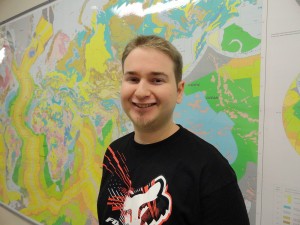 Ground Motion Directivity Effects Derived from 3D Rough-fault Earthquake SimulationsRobert Mordecai Wednesday, December 10th, 2014 |
||
|
||
| ABSTRACT Deterministic ground motion simulations in 3D crustal models are now computationally feasible up to frequencies needed by structural engineers for building design (0-10Hz). At frequencies above ~1Hz, seismic data indicate that simulations need to include frequency-dependent anelastic attenuation (Q(f)). Moreover, high-frequency simulations require small-scale complexity in both source description and crustal structure to generate realistic ground motions, which can be generated by statistical approaches. While such statistical (fractal) distributions of the small-scale variations on the fault and in the crust can be constrained from data, it is important to validate and calibrate the resulting high-frequency synthetic ground motions to observed seismic records. Here, we carry out one such validation test for ground motion directivity effects, an important feature that can significantly amplify and de-amplify the ground motions from earthquakes. The directivity effects are estimated for 0-10Hz ground motion simulations for a single M7.2 strike-slip earthquake scenario. We use various realizations of the scenario that include a geometrically rough-fault source (Shi and Day, 2013; Withers et al., 2013), a layered crustal model with and without small-scale heterogeneities included, and Q(f). Ratios of rotd100 and rotd50 estimates are used as a measure of directivity effects for the simulations, as suggested by the empirical study by Shahi and Baker (2012). Our results indicate that the small-scale heterogeneities in the media are necessary to reproduce the empirical trend in rotd100/rotd50 ratios, while simulations with small-scale geometrical complexity on the fault by itself do not reproduce the decrease in the ratios for periods shorter than ~1s. The ratios generally increase for stations toward the fault (distances of 0-10 km, measured along ‘race tracks’), in agreement with empirical data. Q(f) is found to have insignificant effect on the directivity estimates. As expected, the largest ratios are found toward the ends of the fault. However, another region of increased ratios is found ~perpendicular to the fault extending away from the epicentral area. Further analysis with additional source descriptions is needed to assess how general this effect is. Finally, our results may be used to generate an improved parameterized model for including directivity effects into ground motion estimates, such as Ground Motion Prediction Equations. |

